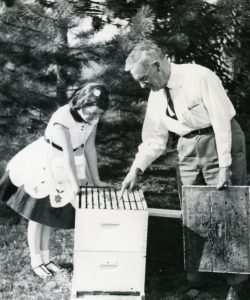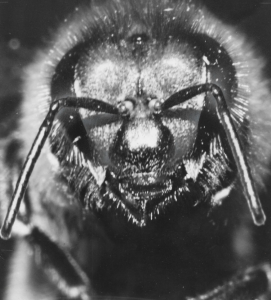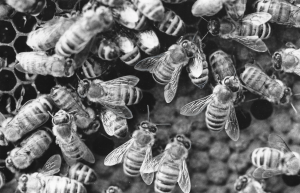By: Mark Price
What was in the box? Businessmen looked curiously at the large wooden container as they took their seats for the Akron Lions Club meeting.
Soon they were buzzing with excitement.
More than 75 members attended the luncheon 100 years ago at the YWCA at 22 S. High St., a site occupied today by the downtown parking deck for Akron-Summit County Public Library. Founded a year earlier under the principle of “unselfish service to others,” the Akron club welcomed guest speakers each week.
They would not soon forget the lecture of Nov. 15, 1921.

Photo of Huber H. Root
Inventor, author and chemist Huber H. Root, 38, served as general manager of the A.I. Root Co., which his father, Amos, had founded in Medina in 1869. A national expert on bees, H.H. Root had served as an editor and contributor to such publications as Gleanings in Bee Culture, Alexander’s Writings on Practical Bee Culture and The ABC and XYZ of Bee Culture.
He presented lectures across the country and spoke of honey bees with great fervor.
“Bees were not created to make honey,” he told audiences. “They were created to cross-pollinate flowers. The honey making is merely a useful side industry.
Bees do not get honey from the flowers. What they get from the flower is a cane syrup. Through their bodies, this is converted into grape sugar in a mysterious little laboratory that nobody understands.
When a bee is hungry it opens up a little valve from this laboratory into its stomach. When its stomach is full, it shuts off the valve.”
The Akron Lions listened to Root’s presentation with interest. They had all but forgotten about the wooden container until Root motioned to it.
“Now, in this box, I have a beehive and a full swarm of bees,” Root said. “They won’t sting me, of course. But I cannot say what they might do to you.”
Club members laughed.

According to A.I. Root Co. Executive Huber H. Root: this un-retouched picture of the head of an Italian honey bee was taken to show the particles of pollen in the hair, thus
dramatizing the bees’ contribution to horticulture.
Beacon Journal File Photo
“You’re joking. Can’t be any bees in that box,” said Dow Harter, founding president, U.S. commissioner and future U.S. congressman.
“We’ll see whether I’m joking,” Root said as he undid the latch and lifted the lid.
An undulating mass of yellow and black teemed inside. As Root pointed out the combs laden with insects and honey, about 40,000 bees were turned loose on the small assembly hall. Pandemonium swept the room as the Lions ducked under tables and covered their heads with tablecloths and napkins.
“Consternation occurred among the club members as the thousands of bees swarmed about them alighting in their hair, on their faces, hands and their clothing,” the Akron Evening Times reported.
“Some, who forgot the admonition of Mr. Root not to slap the bees, and tried to shoo them away, were heard to cry out lustily. A few timid ones, who attempted to make for the door when the insects were released, were deterred by the shouts of their brother members.”
The sound of Root’s muffled laughter cut through the buzzing. When the Lions finally dared to look up, they were amazed to see that Root was covered in bees.
He carefully shook off the insects, put them back in the hive and fastened the lid.
“A bee can’t sting unless he sits down,” Root said. “And my bees are all trained to stand up.”
The Lions chuckled as they returned to their seats, amazed by the startling demonstration.
While the Beacon Journal reported that no club members had been stung, the Evening Times mentioned a “few casualties,” but noted that there wouldn’t be “many downtown businessmen who will go home to their wives this evening nursing a swollen jaw, eye or something else.”
Explaining the inner workings of a hive, Root said the bee colony “is the only real social colony in the world.”
“Nobody gives orders in a bee community,” Root said. “There is no division of labor. If a bee sees there is work to be done, it goes and does it.”
Contrary to popular belief, he said, the queen is not the ruler of the colony but is subservient to the wish of the workers who exert total control.
The workers are not neuters but immature females, he said, and queens are mature females. The queen’s job is to lay eggs. If the workers want more eggs, they feed the queen more, Root said. If the workers want fewer eggs, they feed her less.
A queen will lay two and a half times her weight in eggs every 24 hours, Root noted. She eats two and a half times her weight every day. And there can only be one. Two queens will fight to the death.
“The drones have been maligned a great deal for being lazy,” he said. “That is unjust. Nature has not equipped the drones with tongues and stings so that they can work. When there is plenty of honey, the drones are tolerated. When the food supply runs low, the drones are thrown out to starve.”
The Lions probably learned more about bees that day than they ever expected. The incident made national headlines.

National bee expert Huber H. Root called bees “the only real social colony in the world.”
Beacon Journal File Photo
Bee allergies must not have been a common concern 100 years ago, because Root pulled the same stunt at lectures across Ohio. Several months later, he gave a talk at West High School in Akron.
“What sort of institution do you think this would be if every individual thought only of bettering the high school?” Root told students. “Suppose nobody thought anything of self-advancement. Suppose a school where the community spirit was 100 percent.”
Students shouted and shrieked as Root opened the hive and let 40,000 bees loose. He told the children not to panic.
“Bees don’t like nervous people, but it is hard to get them to sting in self-defense,” Root said. “They reserve their stings for the defense of the hive.”
The bees returned to the box. No stings were reported.
Root repeated the stunt that week at Central, North and South high schools.
We live in a different world than a century ago. Try to imagine school officials allowing such a demonstration today.
H.H. Root went on to serve as president and chairman of the A.I. Root Co. Board. He introduced rolled beeswax candles, which were more resistant to heat, and invented a glass-encased sanctuary light that kept wax from dripping in churches.
He also wrote the 1951 textbook Beeswax, Its Properties, Testing, Production and Applications.
Root was 88 years old when he died in 1972.
The A.I. Root Co. celebrated its 150th anniversary in 2019. The fifth-generation, family-owned business, which continues to call Medina home, produces about 20 million candles a year and touts its products as “The Best Candles in America.”
The company has been generating a buzz since 1869.
But don’t worry: It no longer releases 40,000 bees at public meetings.
Mark J. Price can be reached at mprice@thebeaconjournal.com.








